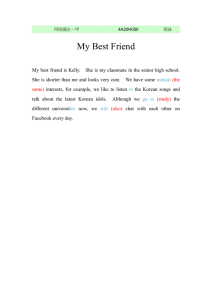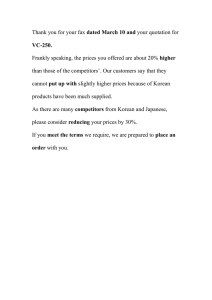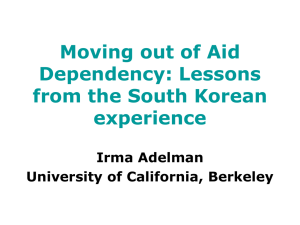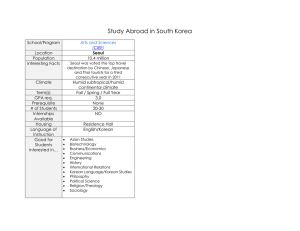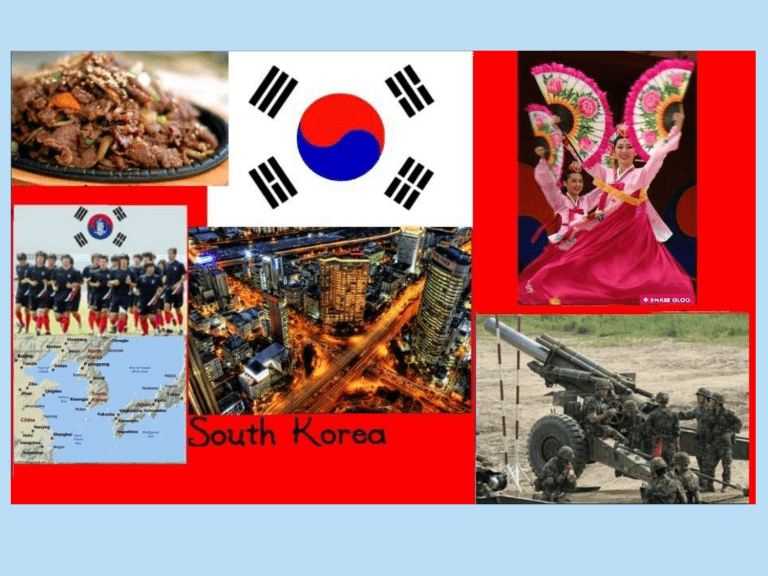
Globe.One Cross cultural training Flow of Presentation • • • • • • • • • • Introduction to South Korea Greetings and Addressing Body Language Language and its connotations Timing and Punctuality Behavior at Meal and Tipping Significance of Colors Dress Code Gifting Quiz Demographics Capital – Seoul Official Language – Korean Area - Total 100,210 km2 (108th) Population(2010 estimate) - 48,875,000 MAJOR RELIGION(S): No affiliation 46.5%,Christian 26%, Buddhist 26%, Confucianism 1%, other 1%. • Density - 491/km2 • • • • • Korean Economy • GDP (PPP) 2010 estimate - Total $1.459 trillion - Per capita $29,835 • GDP (nominal) 2010 estimate - Total $1.007 trillion - Per capita $20,590 • Gini (2010) .316 • HDI (2010) 0.877 • Currency South Korean won (₩) (KRW) • In 2010, South Korea was the sixth largest exporter and tenth largest importer in the world India – South Korea relations • South Korea is currently the • fifth largest source of investment in India. • Korea-India Comprehensive Economic Partnership Agreement (CEPA) effected in January last year • Trade increased exponentially from $530 million during the fiscal year of 1992-1993, and the $10.7 billion during 2010-2011. Greeting and Addressing • Greeting customs are highly culture and situation specific • It can be audibly • It can be physically • A combination of the two • Use titles such as “Dr.”, “Mr.” and “Mrs.” to demonstrate respect Greeting and Addressing • Bow is the most common method • Shaking hands • Posture • Greetings are vocalized when bowing Greeting and Addressing Men greeting Men:• Korean men bow to one another when greeting and departing Women greeting Women: • Bow is common Greetings between Men & Women:• Bow is common. In business settings a handshake is also common. Social gathering: • Wait to be introduced • When you leave good-bye and bow to each person individually DIFFERENT BOWS • Respectful 30º ~ 45º Bow:- The most common, this is the standard bow. It is commonly used in business environments. DIFFERENT BOWS(Contd..) • “Belly-button” Bow: - Formal respectful bow that is mostly used by women in uniform DIFFERENT BOWS(Contd..) • 90º Bow: - It’s a form of utter respect, an intentional showing of service and obedience. DIFFERENT BOWS(Contd..) • Big Bow: - “Big Bows” are reserved for special occasions to show extreme remorse or gratitude. The method of bowing is different for men and women. GREETING THE DOS:• When shaking hands, support your right forearm with your left hand. • Return bows if you are receiving one. • Say hello, thank you etc along with bow • Bowing occurs from the waist • While bowing stand straight with knees closed. • The younger man should bow lower than the older man • When you leave a social gathering, say good-bye and bow to each person individually. GREETING(Contd..) THE DON’TS:• Do not bow deeper to someone when you are already with another person who is that someone’s senior. • Do not bow “down” to someone, when you are on a staircase. • The “silent bow” is just plain rude, unless you’re in an environment where you have to be quiet like the library or theater. • Don’t try to bow while moving. • Koreans don’t bow with their hands together in a prayer pose unless they’re Buddhist or in a religious setting GREETING-KOREA THE DON’TS:• Don’t be bird head GREETING-KOREA THE DON’TS:• Don’t be a gorilla:- Keep your arms naturally at your side. Personal Space and Touching • Koreans prefer to stand at arms length distance from one another. • Both gender are very comfortable in each others spaces if friends. • No apologies fro bumping into other people. • Expect limited personal space and a lot of pushing in public areas. • PDAs are not acceptable in Korean Culture. Personal Space and Touching(Contd..) • While greeting, a big no no to hugging and kissing. • It is ok for a teacher to knock his student’s head(lightly). • Feet should not touch people or objects. Eye Contact • Indirect eye contact is favored over direct eye contact. • During conversations both direct and indirect is acceptable. • When speaking with elders, Koreans usually use indirect eye contact. • Refrain from staring. Gestures • It is best to point with your whole hand or middle finger. • To call someone use a palm that is facing downwards. • Beckoning with the palm up is reserved for calling animals. • Use two hands while offering or receiving something. • Talking or laughing loudly is considered impolite. Gestures (Contd..) • Spitting on the street is not uncommon. • Take your shoes off when entering a Korean home. • It is considered impolite entering a room without knocking. • Blowing ones nose in public is considered rude. • Avoid facial expressions and big hand/arm gestures during conversation. Brief Recap • Do’s – Maintain arm length distance from others. – Prefer indirect over direct eye contact. – Use palm facing downwards when calling someone. – Take your shoes off when entering a Korean home. – Use both hands while receiving or offering something. – Use whole hand or middle finger to point. Brief Recap(Contd..) • Don’ts – Kiss or Hug when greeting someone – Talk or laugh loudly – Use direct eye contact wit elders – Enter a room without knocking – Use facial expressions and big hand/arm gestures during conversation – Blow your nose in public Language and connotations Importance & Need • Shortcut to gain respect of Koreans. Example: reading their name, in Korean, from a business card. • Makes things easier in the country. Example: Giving Instruction to the driver of the cab • All relevant Documentation should be made available in both English & Korean. Basic Words: Translation and Phonetics English Word Korean Translation Phonetics Hello 안녕하세요 annyeonghaseyo Good night 안녕히 주무세요 annyeonghi jumuseyo Do’s & Don’ts Do’s Don’ts Documentation to be made available both in English & Korean. Do not use Korean, when not confident. Learn the Korean translation of words used daily. Read Client’s name in Korean, from a business card. Timing and punctuality Timings: Working Hours • Business Hours 9 AM to 5 PM Monday to Friday • Time difference Korea is 3:30 hours ahead of India • Holidays A Korean Calendar should always be kept handy Timings: Working Hours Duration • Duration preferred over Quality. • Senior Managers usually stay till late. • Recommendation: Staff Members should avoid ending their day before their Boss. Timings: Business Appointments • Planning & Proactive Communication: Prior Appointments are required. At least 3 to 4 weeks in advance • Best Meeting Timings: 10:00 AM to 12 Noon (KST ) 2:00 PM to 4:00 PM (KST ) Note: KST-South Korean Standard Time Punctuality: Business Appointments • Expectations • Avoid Weak Excuses when you are late. • Ground Rule: Arrive on time for meetings, as this demonstrates respect for the person concerned. Punctuality: Social Gatherings • Movies & other public events tend to begin late. • Koreans themselves are fairly relaxed about time. • Its normal to be 15 to 20 minutes late but rude to be later than 30 minutes. Do’s & Don'ts DO’s Don'ts Send the invitation & agenda of the Leave for home before your appointment, 3 to 4 weeks prior to superior. the actual date. Avoid scheduling business meetings b/w mid-July to midAugust or any other national holiday. Get late for the meeting. Check South Korea’s calendar before fixing an appointment. Pin point the Korean client if he comes late Give an excuse of traffic when you arrive late. Dining Etiquette If you are invited to a South Korean's house: • It is common for guests to meet at a common spot and travel together. • You may arrive up to 15-20 minutes late. • Remove your shoes before entering the house. • The hosts greet each guest individually. • The host pours drinks for the guests in their presence. (the hostess does not pour drinks) • The hosts usually accompany guests to the gate or to their car because they believe that it is insulting to wish your guests farewell indoors. • Send a thank you note the following day after being invited to dinner. Table Manners • Wait to be told where to sit. There is often a strict protocol to be followed. • The eldest are served first. • The oldest or most senior person starts the eating process. • Never point your chopsticks. • Do not pierce your food with chopsticks. • Chopsticks should be returned to the table after every few bites and when you drink or stop to speak. • Do not cross your chopsticks when putting them on the chopstick rest. Table Manner (Contd..) • Do not pick up food with your hands. Fruit should be speared with a toothpick. • Bones and shells should be put on the table or an extra plate. • Try a little bit of everything. It is acceptable to ask what something is. • Refuse the first offer of second helpings. • Finish everything on your plate. • Indicate you are finished eating by placing your chopsticks on the chopstick rest or on the table. Never place them parallel across your rice bowl. Eating and Drinking • Koreans use chopsticks with a twist: alone among the peoples of Asia, they prefer chopsticks of metal. • Typically, restaurants have stainless steel chopsticks, but fine silver ones are also available. • Unfortunately for the chopstick learner, these thin and slippery sticks are not the best implements to practice with, but if you can eat with wooden or plastic chopsticks you'll manage with some fumbling. • When eating as a group, communal dishes will be placed in the center and everybody can chopstick what they want, but you'll still get individual portions of rice and soup. • Unless you are eating royal cuisine, most dishes are served family style. Eating and Drinking(Contd..) • In many traditional households, children were taught that it was impolite to speak during meals. • Don't be surprised if there's complete silence while eating. People, particularly men, will use mealtimes to quickly eat up and move on to other things. • This can be attributed to the short mealtimes during military service that most young Korean men must perform. Some etiquette pointers • Do not leave chopsticks sticking upright in a dish, especially rice. This is only done when honoring the deceased. • Similarly, a spoon sticking upright into a bowl of rice is also not a good sign. • Do not start eating unless the eldest at the table has begun to eat. • Do not lift any plates or bowls off the table while eating, as Koreans consider this to be rude. • You can use your spoon to eat your rice and soup. Koreans will normally use a spoon to eat their rice and use chopsticks to eat the other dishes. • Don't be self-conscious of whether you're doing something right or wrong. Just use your common sense of politeness and good manners, and everything will be fine. Some etiquette pointers (Contd..) • In addition to chopsticks, South Koreans regularly use soup spoons at meals. • The chopsticks are used primarily for side dishes, while the spoon is used for soup and rice. • Unlike in Japan, it's not appropriate to pick up your rice bowl while eating. All plates and bowls should stay on the table. Drinking in South Korea There are a few etiquette rules to observe when drinking with Koreans such as: •You're not supposed to fill your own glass; instead, keep an eye on others' glasses, fill them up when they become empty (but not before), and they'll return the favor. •It's considered polite and respectful to use both hands when pouring for somebody. Though filling a companion's glass with beer or soju (similar to vodka) is appropriate, it's essential that the glass is completely empty before pouring. •This may seem like a trivial concern, but will count for a lot in the eyes of your South Korean friends. •Turn your head away from seniors when drinking. Drinking in South Korea (Contd..) • Younger people often have a difficult time refusing a drink from an older person, so be aware when asking someone younger than you if they want to drink more as they will often feel unable to say no to you. • Of course, this works both ways. Often times, if an older person feels you are not keeping up with the party, he may offer you his glass, which he will then fill and expect you to drink. • It is considered polite to promptly return the empty glass and refill it. Paying when Socializing • Among young people, the person who issued the invitation usually pays. • If you're out with a group, the bill is split and everyone pitches in. • Among older Koreans, one person will take care of the bill, and roles will switch the next time. Tipping • Tipping is not a traditional Korean custom; however, a 10 percent service charge is added to bills at all tourist hotels and tipping is not expected. • As a rule, tipping is not necessary anywhere in Korea, and is not practised by locals, although bellhops, hotel maids, taxi drivers and bars frequented by Westerners will not reject any tips you care to hand out. Significance of Colors to The People of South Korea TAEGEUKGI TAEGEUKGI, is the national flag of Korea. • Taegeukgi is based on the colour white. • There is a large circle in the center. o The circle is divided into two colours, red & blue. • Taegeukgi also has the black Gwae of four. The Color WHITE Relevance to the National Flag • White represents both land & peace. • Korean people respect peace of the world. • White stands for Korea’s territory. Relevance to people • Korean people were called: “The whiteclad folk,” which refers to Innocence. • They wear white clothes on the first day of the new year. • White signifies a pure & innocent attitude. The Colour BLUE Relevance to the National Flag Relevance to people • Blue refers to shade, water & Land. • Blue symbolizes integrity. • Blue is one half of the circle in the center, its contrasted with another colour, Red. • During the Chosun Dynasty, a scholar, a man of virtue, was accepted as a person of integrity. • Their goal was to live a life, wherein they could keep their hands clean. The Colour RED Relevance to the National Flag • Red is one half of the circle in the center, its contrasted with another colour, Blue. • Red means brightness, fire & sky. • Taken together with Blue, they stand for harmony. Relevance to People • Modern day Korea is represented by Red. • Red Devil, is the name of the supporters of the Korean soccer team. • This title was given by commentators during FIFA in Mexico 1983. • Korean’s wear red clothes & they crowd around the city hall for hooting. Conclusion • Korean’s display the color's of significance to the Korean Society, by using them on the TAEGEUKGI or wearing specific colored clothes on specific days. • Koreans like to express their racial characteristics by using colors. • White signifies innocence of the white-clad folk. • Blue signifies integrity. • Red symbolizes the passion of the Red Devil. • The colors of Korea, are represented by their behavior & their national flag. The colors that primarily represent Korea are white, blue, and red. DRESSING-Introduction • The culture of Korea is one of the world’s oldest. • The traditional dress is known as hanbok • Koreans commonly wear clothes in white, red, yellow, blue, and black. • Formal suits are widely accepted in business environment. HANBOK HANBOK FORMAL DRESS CODE FOR MEN Dos:• Dark colored trousers • Light colored full sleeve cotton shirts • Properly polished leather Lace-up shoes • Properly knotted conservative tie reaching the middle of your belt buckle • Socks darker shade of the trouser color • Neat shave, mild after shave and deodorant. • Nails neatly clipped • Hair properly trimmed and combed • No items that bulge in your pockets FORMAL DRESS CODE FOR MEN Don’ts:• Sloppy facial hair • Shiny tie pins or clips or big belt buckles • Visible jewelry • Open top shirt button with a tie. • Short-sleeved dress shirts • Short socks Formal Dress Code for women Dos:• Western business suit • Wear shoes with heels up to 1 ½” to 2” • Simple Jewelry • Nails properly clipped, no colorful nail polish at best use neutral nail polish • Simple make-up • Hair neatly combed and held in place • Use sober colored lipsticks/lip gloss • Use light perfumes or avoid totally Formal Dress Code for women Don’ts:• • • • • • • Anything too bright, tight, sheer or short. Stilettos or Heels so high you're unsteady Too much makeup Wear big, shiny buckles or jewelry Fashion jewelry Earrings that are large or dangle Bangle bracelets (or anything noisy) Occasions for Gifting • Shinjeong:- New Year day; 1 January • Seollal:-1st day of the 1st month in the lunar calendar, also known as "Korean New Year” • Sameeljjeol:- 1st March, in commemoration of the March 1st resistance movement against the invading Japanese Imperial Army in 1919. • Orininal:- means Children's Day, 5th May Occasions for Gifting(contd.) • Buchonnim osinnal or sawolchopa-il:- means Buddha's birthday, 8thday of the 4th month in the lunar calendar • Hyeonchung-il:- means memorial day, 6th June. In commemoration of people who gave their lives to the nation. • Gwangbokjjeol:- means Independence Day, 15th August Occasions for Gifting(contd.) • Chuseok:- often dubbed "Korean Thanksgiving", is celebrated on the 15th day of the 8th lunar month of the year. • Christmas:- has become a major holiday in Korea due to the large number of Christian converts in recent times. • Birthdays, Anniversaries and other personnel occasions. General Gifts • Korean Paper Fans • Korean Seals • Korean pendant with name written in Hangul Characters. • Korean Green Tea • Korean Hanbok Teddies. • Korean Bookmarks. • Korean Hair Pin / Brooch. • Korean Hahoe Masks. • Korean Wooden Goose (a symbol of trust and fidelity). • Korean Yut Nori (Indoor Game). • Korean Silk Pouches. • Korean Chop Sticks. • Korean Money Clip. • Korean Clay Magnets • Korean Key Rings • Korean Hanguel Printed Tees • Korean Clay toys • Korean Rice Cake. • Korean Walnut Chocolate. • Korean Antiques. • Coffee Mugs with Korean Prints or colourfull prints • Korean Bokjori Gifts Gifts for Boys Gifts for Girls Gifts for Kids Gifts for Boys • Korean Soccer Player T-Shirts. • Electronic Gadgets like mp3/mp4 player from Yongsan. • Korean Tie pins. • Male purses • iPod Covers n Accessories. • Korean Movie collection. • Korean Smoking Pipes. • Korean winter jackets • Hiking gear • Scarf (Sukapu), gloves and caps Gifts for Girls • Clothes – if you tired of Dongdaemun and Namdaemun then you visit the market at Guson Bus Terminal, Hangang Park. • Cosmetics – Aritaum, Etude, Face Shop, Neutrogena and so many other brands. • Jewellery and accessories. • Bags with Korean Prints. • Shoes. • Korean Winter collection, scarf, hood tees, gloves…. Gifts for Kids • Hanbok Dress. • Korean Traditional Game – Yut Nori. • Make your own Korean Paper Castle games. • Pencil box and other stationary. • Soft toys. Do’s and Don’ts • Bring fruit or good quality chocolates or flowers if invited to a Korean's home. • Giving 7 of an item is considered lucky • Gifts should be wrapped nicely • Don’t give someone an expensive gift if you know that they cannot afford to reciprocate accordingly • Don’t give gifts multiples of 4. The number 4 is considered to be unlucky Do’s and Don’ts • Use both hands • Do not wrap gifts when offering a gift in green, white, or black paper. • Wrap gifts in red or yellow paper, since these are royal • Do not sign a card colours. in red ink. • Alternatively, use yellow or pink • Don’t open gifts paper since they immediately after denote happiness. receiving it. Quiz 1. When meeting a Korean on business, how should you address them? a)With title and surname b)With surname c)With first name 2. Gifts are exchanged in business as... a)Bribes b)A way of opening negotiations c)A way of cementing relationships 3. When receiving a gift it is good etiquette to... a)Kiss the givers right shoulder b)Refuse it three times c)Accept it with the left hand while shaking hands with the right 4. When reciprocating in gift giving, what should you do? a)Make sure the gift you give in return is more expensive. b)Make sure the gift you give in return is of equal value/worth. 5. If you were to buy a Korean one of these gifts, which would be the most suitable? a)Business stationery b)Craft item from your own country c)Chocolates Quiz(Contd..) 6. Putting business cards into a pocket is considered rude. a)True b)False 7. When receiving a business card you should do so with... a)Left hand propped up with right hand b)Both hands c)Right hand only 8. Maintaining eye contact is considered good etiquette. a)True b)False 9. Which of these religions has an influence over Korean culture and values? a)Buddhism b)Confucianism c)Paganism 10. How do Koreans greet one another? a)Rub noses b)Shake hands c)Bow Answer key: 1.a 2.c 3.c 4.b 5.b 6.a 7.b 8.b 9.a 10. c
